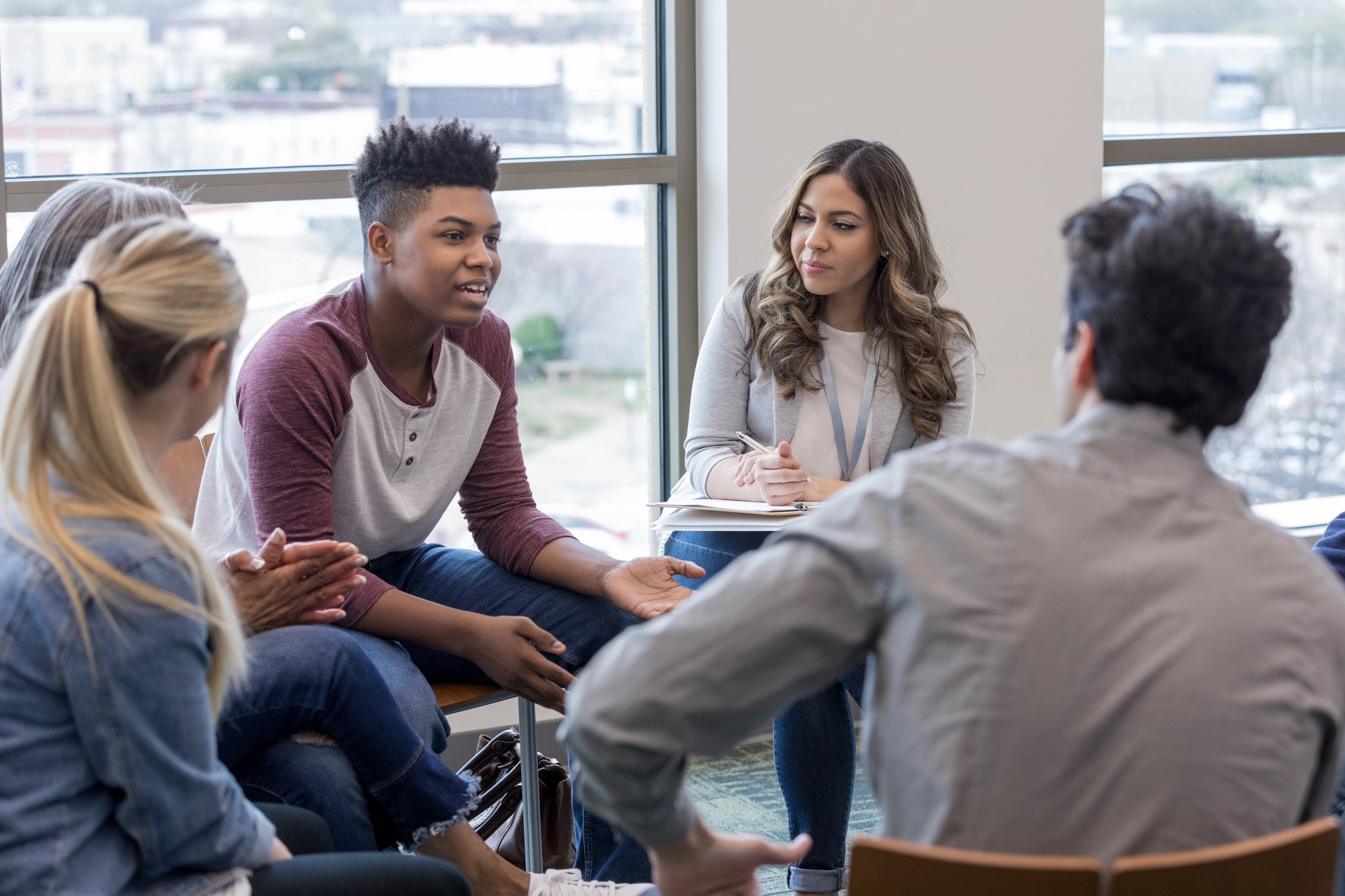What Are Restorative Justice Circles, and When Can They be Utilized?
Restorative justice circles are a great tool for building relationships and achieving goals. Here's how you can use them in your classroom and beyond.

In a time of overlapping and interconnected health, wellness, and social justice crises, it’s increasingly important to create opportunities for processing a range of feelings and emotions, as well as making meaningful connections with one another. To help, we’re offering up a guide to community building restorative justice circles (sometimes referred to as listening circles) as a way to provide students, teachers, and educators with a space to connect and share.
What is a Restorative Justice Circle?
Restorative justice circles are born out of indigenous (pre-colonized) societies around the world. Circles tap into our communal nature, and our desire to be in positive relationships with one another. In circles, no one is seen as dispensable and everyone is valued for their knowledge and unique gifts. In this way, communities remain whole and reciprocal. Circles build accountability between individuals and the larger community.
Restorative circles can be utilized in a number of ways, including but not limited to:
- Building and strengthening relationships and communities
- Healing harms and increasing accountability
- Fostering connectivity in ways that allow all community members to thrive and feel valued
- Reintegrating community members who have been removed (for example, students returning from suspension)
- Addressing concerns or clarifying meaning (i.e. lesson plans and activities, policies and procedures, processes, systems, and structures)
- Approaching challenging conversations
- Celebrating achievements and milestones
- Planning and organizing
- Redistributing power and/or dismantling systems of power and hierarchy
Identifying the Goal of Your Restorative Justice Circle
While particular occurrences or moments can be a catalyst for circling, restorative justice circles can occur without a specified topic. The goal of the circle can be simply to come together as a community.
However, without a topic (and sometimes even with one), it’s important to consider what to do in the event of lulls in the conversation, or lack of interest from participants. It’s also worth noting that even if some participants have little to share, they still benefit from being a part of the circle and the community. Circles aren’t always smooth or easy, but they are always meaningful.
The range for the types of circles that can be held is extensive. The 433-page spiral-bound circle guide, Circle Forward, outlines hundreds of circle topics and plans for executing them are outlined. In addition, some examples of topics that school communities have approached in circles include:
- Resolving conflict among staff within a team or department
- Students discussing the impacts of using marijuana
- Students holding a remembrance circle in honor of a classmate who passed away
- Students exploring gender identity and norms, and toxic masculinity
- Students resolving conflict that transpired over social media
- Parents reflecting on how to strengthen relationships with their children
- Students discussing scapegoating, loyalty, and boundary-setting within their friendships
- Students reflecting on a police incident inside the school, followed by a discussion about the relationship between the school and the nearby precinct
- Staff team-building
- Students discussing the impacts of colorism
- A science class discussion on genetic modification and the correlation to the impacts of racism and discrimination
Guidelines on How to Conduct a Restorative Justice Listening Circle
Elements for creating a circle include the following, and can be adapted to a virtual format:
Elements to Create a Restorative Justice Listening Circle
| 1 | Circlekeeper/s | The circlekeeper facilitates the conversation and activities during a circle and monitors the wellbeing of the participants (individually and collectively), i.e., suspending the talking piece, providing additional information, addressing the harm caused at the moment, inserting stretch breaks, and removing or inserting prompts. |
| 2 | Circle set-up and a centerpiece | In person, there is a literal circle set up with the seating, and a centerpiece is placed in the middle as the focal point. This centerpiece is a place to hold items relevant to the circle and its participants. This can be symbolically adapted for a virtual circle. |
| 3 | Opening ceremony | An opening ceremony sets the tone of the circle and creates an inviting environment to allow participants the opportunity to share. During this time, the facilitator should introduce the circle’s topic/s. The opening ceremony should also include a symbol to signal the official start of the circle. This can be a poem, video clip, quote, song snippet, etc. |
| 4 | Talking piece | A talking piece is an item passed from person to person to facilitate equity of voice. This can be an item that holds sentimental value, or a trinket, such as a rock, small stuffed animal, kush ball, or anything that can be passed easily. In virtual environments, members can pass from person to person by sharing an order list in the chat or announcing the name of the person to whom you are passing the “talking piece”. |
| 5 | Community agreements | Community agreements are needed to ensure that participants can feel comfortable sharing honestly and openly during the discussion. Authentic communication is crucial in reaching increased understanding and resolution. The circle community arrives at the agreements collaboratively. Examples of community agreements might include: respect the talking piece, ensure equity of voice, remain present and engaged, speak and listen from the heart, and keep personal details confidential. Agreements should be revisited during each circle. |
| 6 | Prompts or rounds | Prompts and rounds are questions or phrases that help guide the discussion. They are especially helpful when there is a predetermined topic for the circle, or if the circle is in response to a crisis. Without prompts, a circle discussion can lose its impact, veer off into unintended territory, and/or cause further harm to relationships. |
| 7 | Closing ceremony | The closing ceremony is a way to wrap up the discussion and thank everyone for bringing themselves to the circle and contributing to the discussion. In the closing, you may leave participants with a particular idea to ponder, signal discussions to come, or reveal the next steps. |
Circle in Practice: Make Space for Youth Voices and Feelings During Protests Against Police Brutality
It was early June, the coronavirus had quarantined us for 100 days, and ongoing unrest over racial injustice filled the streets. With so much to process, many of us were struggling to make sense of it all, and students had a particularly difficult course to traverse.
In light of the overlapping and interconnected crises, a diverse group of members from the XQ Student Advisory Committee engaged in a virtual restorative circle in order to voice what was on their hearts and minds.
The XQ Student Advisory Committee, formed to incorporate student voices into XQ tools and products, encourages students to rethink their educational experiences and creates young leaders through mentorship and professional development. As expected, the students had plenty to share and were excited to think about the benefits of having access to space like this regularly.
In this circle, the students shared about themselves, the pros and cons of things returning to ‘normal’, perceptions and opinions among their peers, and hopes and fears for the future. Most inspiring, they each reflected on what action might look like for them. Through this sharing, students saw their commonalities and learned from their differences. This helped to illuminate areas where they might be able to support one other, collaborate, or inspire each other to become more informed and involved.
The students only made it through a few of the planned prompts, but this is not uncommon. While structured, circles move organically in the direction and at the speed in which the participants steer it. The experience reinforced that when we provide students the space to share in this way, they build their confidence and self-esteem, are encouraged in their leadership and civic engagement, and assume increased ownership over their learning, growth, and development.
This discussion was a necessary starting point, and a reminder to the adults to continue to make space for these crucial conversations. During the circle closing, students were left to consider the words of Dr. Angela Davis: “I am no longer accepting the things that I cannot change. I am changing the things I cannot accept.”
While the burden of resolving the nation’s and society’s issues around racism is not theirs solely, young people, their perspective, and their energy are desperately needed in this fight. And it’s important they know that the adults will be right there supporting them.
Reflection Questions
- Students and educators, how can restorative justice community circles be utilized within your school community?
- Educators and administrators, what are some structures you have in place currently that would support circles (i.e., small group advisories, team meetings, etc.)?
- Students, what are some topics you’d like to discuss in circle?
Resources for Circles and Peacemaking Practices
- Indigenous Peacemaking Initiative (video)
- The Little Book of Circle Processes Pranis (book)
- Restorative Circles: Creating a Safe Environment for Students to Reflect (video)
- Circle for Change: Restorative Practice (video)
For additional support in circle facilitation and other restorative approaches, or to learn more about how you can hold circles in your school community, feel free to contact Nicole via nicolelavonnesmith.com or nicolelavonne@gmail.com.









